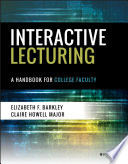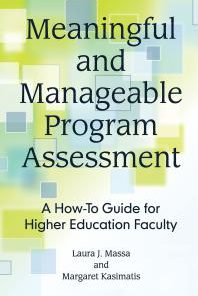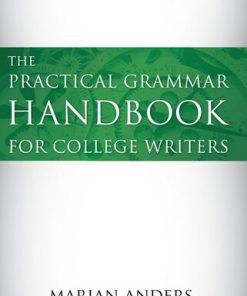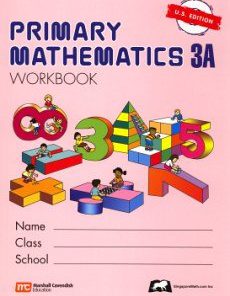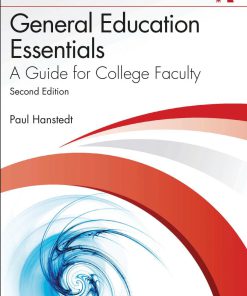Learning Assessment Techniques A Handbook for College Faculty 1st Edition by Elizabeth F Barkley, Claire H Major ISBN 9781119050926 1119050928
$50.00 Original price was: $50.00.$25.00Current price is: $25.00.
Learning Assessment Techniques A Handbook for College Faculty 1st Edition by Elizabeth F Barkley, Claire H Major – Ebook PDF Instant Download/Delivery: 9781119050926, 1119050928
Full download Learning Assessment Techniques A Handbook for College Faculty 1st Edition after payment

Product details:
ISBN 10: 1119050928
ISBN 13: 9781119050926
Author: Elizabeth F Barkley, Claire H Major
Learning Assessment Techniques A Handbook for College Faculty 1st Edition Table of contents:
Part One: The Learning Assessment Techniques Cycle
Chapter 1: Clarifying What You Want Students to Learn
1.1 Defining Learning
1.2 Aiming for Significant Learning
1.3 Using the Learning Goals Inventory (LGI) to Identify Significant Learning Goals
1.4 Expressing What You Want Students to Learn in Language that Is Helpful for Assessment
1.5 Identifying Course-Level Learning Goals
Considering Externally Mandated or Recommended Learning Goals
Considering Students’ Learning Goals
1.6 Considering the Challenges Related to Course Learning Objectives and Outcomes
1.7 Determining Course-Level Learning Objectives
1.8 Identifying Course-Level Student Learning Outcomes (SLOs)
1.9 Differentiating Between Learning Objectives and Learning Outcomes
1.10 Crafting a Course Learning Outcome Statement
1.11 Determining Performance Standards for Individuals and the Class as a Whole
Assessing Achievement of Individual Students
Assessing Achievement at the Course Level
1.12 Is All the Work Required Worth the Effort?
Chapter 2: Determining Your Purpose for Assessing Student Learning
2.1 Defining Assessment
2.2 How Learning Assessment Is Different from Grading
2.3 Types of Learning Assessment
2.4 Assessing Students to Determine for Ourselves How Well Students Are Learning
2.5 Assessing to Give Learners Feedback on Their Progress
2.6 Assessing Learning to Improve Our Profession through the Scholarship of Teaching and Learning (S
2.7 Assessing to Provide Information to Institutional and External Stakeholders on How Well Students
2.8 Crafting the Assessment Question
Chapter 3: Selecting a Learning Assessment Technique
3.1 Using the Learning Goals Inventory (LGI)
3.2 Considering Instructional Context When Choosing a LAT
Traditional Classroom
Online Classes
Collaborative Classrooms
Flipped Classroom
Large Classes
3.3 Key Instructional Elements to Consider
3.4 Considering Clustering Multiple LATs Together
Chapter 4: Implementing a Learning Assessment Technique
4.1 Creating Assessment Rubrics
4.2 Creating Student Self-Evaluation Forms
4.3 Creating Peer Evaluation Forms
4.4 Introducing the Activity
4.5 Providing Students with Information They Need About the Learning Assessment
4.6 Facilitating the Learning Assessment
4.7 Concluding the Activity
4.8 Timing the Phases
4.9 Collecting the Learning Artifacts
4.10 Managing the Learning Artifacts
Chapter 5: Analyzing and Reporting What Students Have Learned
5.1 Identifying Whose Learning You Are Gauging
5.2 Considering Independent and Collaborative Data Analysis
5.3 Scoring Individual Learning Artifacts
5.4 Scoring Group Artifacts
5.5 Determining the Method of Data Analysis
5.6 Using Quantitative Data Analysis
5.7 Using Qualitative Data Analysis
Key Word Analysis
Thematic Analysis
Cross-Case Comparisons
5.8 Displaying Data and Findings
Quantitative Data Display
Spreadsheet Sorted Display
Numeric Table
Pie Chart
Bar or Column Graph
Histogram
Line Graph
Qualitative Data Display
Narrative Table
Word Cloud
Boxed Display
Flow Chart
Modified Venn Diagram
Network
5.9 Interpreting Results
5.10 Writing Up the Results of the Assessment
Case Presentation
The Learning Assessment Technique Matrix
Chapter 6: Closing the Loop
6.1 Modifying Your Learning Goals, Objectives, and Outcomes
6.2 Adjusting Your Purpose for Assessing Learning
6.3 Selecting a Different LAT
6.4 Altering an Aspect of Implementation
6.5 Changing the Way You Analyze or Report Findings
Part Two: Learning Assessment Techniques
Chapter 7: Teaching and Assessing for the Foundational Knowledge Domain
Clarifying Learning Goals Related to Foundational Knowledge
Identifying Learning Outcomes for Foundational Knowledge
Aligning Course Level Foundational Knowledge Learning Outcomes with Institutional Learning Goals
Assessing Achievement of Foundational Knowledge Learning Outcomes
Conclusion
1: First Day Final
Brief Description
Purpose and Use
Key Learning Goals
Implementation
Analysis and Reporting
Examples
Variations and Extensions
Key References and Resources
2: Background Knowledge Probe
Brief Description
Purpose and Use
Key Learning Goals
Implementation
Analysis and Reporting
Examples
Variations and Extensions
Key References and Resources
3: Entry and Exit Tickets
Brief Description
Purposes
Key Learning Goals
Implementation
Analysis and Reporting
Examples
Variations and Extensions
Key References and Resources
4: Guided Reading Notes
Brief Description
Purposes
Key Learning Goals
Implementation
Analysis and Reporting
Examples
Variations and Extensions
Key References and Resources
5: Comprehensive Factors List
Brief Description
Purposes
Key Learning Goals
Implementation
Analysis and Reporting
Examples
Variations and Extensions
Key References and Resources
6: Quick Write
Brief Description
Purposes
Key Learning Goals
Implementation
Analysis and Reporting
Examples
Variations and Extensions
Key References and Resources
7: Best Summary
Brief Description
Purposes
Key Learning Goals
Implementation
Analysis and Reporting
Examples
Variations and Extensions
Key References and Resources
8: Snap Shots
Brief Description
Purpose
Key Learning Goals
Implementation
Analysis and Reporting
Examples
Variations and Extensions
Key References and Resources
9: Team Tests
Brief Description
Purpose
Key Learning Goals
Implementation
Analysis and Reporting
Examples
Variations and Extensions
Key References and Resources
10: Team Games Tournament
Brief Description
Purposes
Key Learning Goals
Implementation
Analysis and Reporting
Examples
Variations and Extensions
Key References and Resources
Chapter 8: Teaching and Assessing for the Application Learning Domain
Clarifying Learning Goals Related to Application Learning
Skills Goals
Critical, Creative, and Practical Thinking Goals
Critical Thinking
Creative Thinking
Practical Thinking
Identifying Learning Outcomes for Application Learning
Aligning Course Level Application Learning Outcomes with Institutional Learning Goals
Assessing Achievement of Application Learning Outcomes
Assessing Skills Learning Outcomes
Assessing Thinking Learning Outcomes
Conclusion
11: Prediction Guide
Brief Description
Purpose and Use
Key Learning Goals
Implementation
Analysis and Reporting
Examples
Variations and Extensions
Key References and Resources
12: Fact or Opinion
Brief Description
Purpose and Use
Key Learning Goals
Implementation
Analysis and Reporting
Examples
Variations and Extensions
Key References and Resources
13: Quotation Commentaries
Brief Description
Purposes
Key Learning Goals
Implementation
Analysis and Reporting
Examples
Variations and Extensions
Key References and Resources
14: Insights-Resources-Application (IRA)
Brief Description
Purpose
Key Learning Goals
Implementation
Analysis and Reporting
Examples
Variations and Extensions
Key References and Resources
15: Consider This
Brief Description
Purpose
Key Learning Goals
Implementation
Analysis and Reporting
Examples
Variations and Extensions
Key Reference and Resource
16: What’s the Problem?
Brief Description
Purpose
Key Learning Goals
Implementation
Analysis and Reporting
Examples
Variations and Extensions
Key References and Resources
17: Think-Aloud Problem-Solving Protocols (TAPPs)
Brief Description
Purpose
Key Learning Goals
Implementation
Analysis and Reporting
Examples
Variations and Extensions
Key References and Resources
18: Peer Problem Review
Brief Description
Purpose
Key Learning Goals
Implementation
Analysis and Reporting
Examples
Variations and Extensions
Key References and Resources
19: Triple Jump
Description
Purpose
Key Learning Goals
Implementation
Analysis and Reporting
Examples
Variations and Extensions
Key References and Resources
20: Digital Projects
Brief Description
Purpose
Key Learning Goals
Implementation
Analysis and Reporting
Examples
Variations and Extensions
Key References and Resources
Chapter 9: Teaching and Assessing for the Integration Domain
Clarifying Learning Goals Related to the Integration Domain
Interdisciplinary Learning
Connecting Academic Work with Other Areas of Life
Identifying Learning Outcomes for Integration Learning
Aligning Course Level Integrative Learning Outcomes with Broader Institutional Learning Goals
Assessing Achievement of Learning in the Integration Domain
Conclusion
21: Knowledge Grid
Brief Description
Purpose
Key Learning Goals
Implementation
Analysis and Reporting
Examples
Variations and Extensions
Key References and Resources
22: Sequence Chains
Description
Purpose
Related Learning Goals
Implementation
Examples
Variations and Extensions
Key References and Resources
23: Concept Maps
Brief Description
Purpose
Key Learning Goals
Implementation
Analysis and Reporting
Examples
Variations and Extensions
Key References and Resources
24: Contemporary Issues Journal
Brief Description
Purpose
Key Learning Goals
Implementation
Analysis and Reporting
Examples
Variations and Extensions
Key References and Resources
25: Dyadic Essay
Brief Description
Purpose
Key Learning Goals
Implementation
Analysis and Reporting
Examples
Variations and Extensions
Key References and Resources
26: Synthesis Paper
Brief Description
Purpose
Key Learning Goals
Implementation
Analysis and Reporting
Examples
Variations and Extensions
Key References and Resources
27: Case Study
Brief Description
Purpose
Key Learning Goals
Implementation
Analysis and Reporting
Examples
Variations and Extensions
Key References and Resources
28: Class Book
Brief Description
Purpose
Key Learning Goals
Implementation
Analysis and Reporting
Examples
Variations and Extensions
Key References and Resources
29: E-Portfolios
Brief Description
Purpose
Key Learning Goals
Implementation
Analysis and Reporting
Examples
Variations and Extensions
Key References and Resources
Chapter 10: Teaching and Assessing for the Human Dimension Domain
Clarifying Learning Goals Related to the Human Dimension Domain
Identifying Learning Outcomes for Human Dimension Learning
Aligning Course Level Human Dimension Learning Outcomes with Institutional Learning Goals
Assessing Achievement of Learning Regarding the Human Dimension Domain
Conclusion
30: Free Discussion
Brief Description
Purpose
Key Learning Goals
Implementation
Analysis and Reporting
Examples
Variations and Extensions
Key References and Resources
31: Nominations
Brief Description
Purpose
Key Learning Goals
Implementation
Analysis and Reporting
Examples
Variations and Extensions
Key References and Resources
32: Editorial Review
Brief Description
Purpose
Key Learning Goals
Implementation
Analysis and Reporting
Examples
Variations and Extensions
Key References and Resources
33: Dramatic Dialogues
Brief Description
Purpose
Key Learning Goals
Implementation
Analysis and Reporting
Examples
Variations and Extensions
Key References and Resources
34: Role Play
Brief Description
Purpose
Key Learning Goals
Implementation
Analysis and Reporting
Examples
Variations and Extensions
Key References and Resources
35: Ethical Dilemma
Brief Description
Purpose
Key Learning Goals
Implementation
Analysis and Reporting
Examples
Variations and Extensions
Key References and Resources
36: Digital Story
Brief Description
Purpose
Key Learning Goals
Implementation
Analysis and Reporting
Examples
Variations and Extensions
Key References and Resources
Chapter 11: Teaching and Assessing for the Caring Domain
Clarifying Learning Goals Related to the Caring Domain
Promoting Caring in an Educational Context
Identifying Learning Outcomes for the Caring Domain
Aligning Learning Outcomes Related to Caring with Institutional Learning Goals
Assessing Achievement of Learning Outcomes in the Caring Domain
Conclusion
37: Stand Where You Stand
Brief Description
Purpose
Key Learning Goals
Implementation
Analysis and Reporting
Examples
Variations and Extensions
Key References and Resources
38: Three-Minute Message
Brief Description
Purpose
Key Learning Goals
Implementation
Analysis and Reporting
Examples
Variations and Extensions
Key References and Resources
39: Issue Awareness Ad
Brief Description
Purpose
Key Learning Goals
Implementation
Analysis and Reporting
Examples
Variations and Extensions
Key References and Resources
40: Proclamations
Brief Description
Purpose
Key Learning Goals
Implementation
Analysis and Reporting
Examples
Variations and Extensions
Key References and Resources
41: Editorial
Brief Description
Purpose
Key Learning Goals
Implementation
Analysis and Reporting
Examples
Variations and Extensions
Key References and Resources
42: Debate
Description
Purpose
Key Learning Goals
Implementation
Analysis and Reporting
Examples
Variations and Extensions
Key References and Resources
43: Briefing Paper
Brief Description
Purpose
Key Learning Goals
Implementation
Analysis and Reporting
Examples
Variations and Extensions
Key References and Resources
Chapter 12: Teaching and Assessing for the Learning How to Learn Domain
Clarifying Learning Goals Related to the Learning How to Learn Domain
Identifying Learning Outcomes for the Learning How to Learn Domain
Aligning Learning Outcomes Related to Learning How to Learn with Institutional Learning Goals
Assessing Achievement of Learning Outcomes in the Learning How to Learn Domain
Conclusion
44: Study Outlines
Brief Description
Purpose
Key Learning Goals
Implementation
Analysis and Reporting
Examples
Variations and Extensions
Key References and Resources
45: Student Generated Rubrics
Brief Description
Purpose
Key Learning Goals
Implementation
Analysis and Reporting
Examples
Variations and Extensions
Key References and Resources
46: Invent the Quiz
Brief Description
Purpose
Key Learning Goals
Implementation
Analysis and Reporting
Examples
Variations and Extensions
Key References and Resources
47: Learning Goal Listing
Brief Description
Purpose
Key Learning Goals
Implementation
Analysis and Reporting
Examples
Variations and Extensions
Key References and Resources
48: What? So What? Now What? Journal
Brief Description
Purpose
Key Learning Goals
Implementation
Analysis and Reporting
Examples
Variations and Extensions
Key References and Resources
49: Multiple-Task Mastery Checklist
Brief Description
Purpose
Key Learning Goals
Implementation
Analysis and Reporting
Examples
Variations and Extensions
50: Personal Learning Environment
Brief Description
Purpose
Key Learning Goals
Implementation
Analysis and Reporting
Example
Variations and Extensions
People also search for Learning Assessment Techniques A Handbook for College Faculty 1st Edition:
learning strategies and assessment techniques
tools and techniques of assessment for learning
the following assessment techniques identify learning gaps
assessment techniques to evaluate student learning
tools and techniques of assessment for learning physical science
Tags: Elizabeth F Barkley, Claire H Major, Learning Assessment Techniques, College Faculty
You may also like…
Biography & Autobiography - Sports & Adventure Biography
Education Studies & Teaching - Special Education
Education Studies & Teaching - Higher & Further Education
Interactive Lecturing A Handbook for College Faculty 1st Edition Elizabeth F Barkley Claire H Major
Uncategorized
dictionaries & phrasebooks
The Practical Grammar Handbook for College Writers 3rd Edition Marian Anders
Education Studies & Teaching
Assessment for Experiential Learning 1st Edition Cecilia Ka Yuk Chan
Uncategorized
Education Studies & Teaching - Educational Theory
General Education Essentials: A Guide for College Faculty, 2nd 2nd Edition Paul Hanstedt





